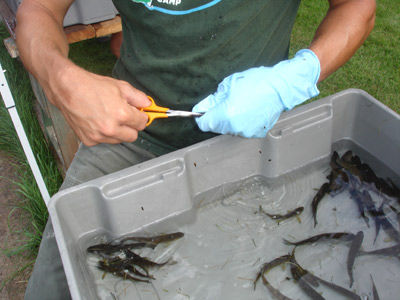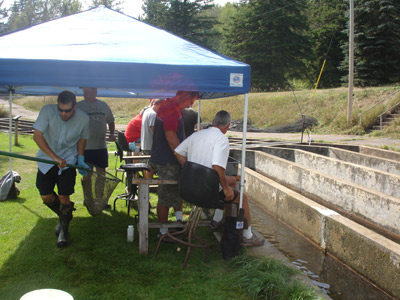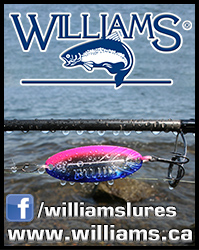FENCEROWS...Clipping Fins
By John Luthens
There are tales of extreme fishermen who cut a ballistic swath through a body of water, wading and trolling, and leaving rippling wakes of caught fish behind. Their fishing logs display such eye-popping scores of hook-ups, that a master accountant would be hard pressed to juggle the numbers into the realm of believability.
Hard-core fly fishermen call it “ripping lips.” While I’ve seldom been lucky enough to play on that level, last week by 10 a.m. on the fourth of September according to my log book, I’d caught and released somewhere in the neighborhood of 500 brown trout.
The sun was peeking over the pines and popples of northwestern Wisconsin’s Brule River Valley, and it was bright enough to dwindle the trout fishing down to midday levels, which usually means you won’t catch anything until it the sun starts its late-afternoon slide. But the action kept steadily coming.
I wasn’t even using a fishing rod; I was catching the trout with my bare hands. I wasn’t using a hook-sharpened fly either. I was using a small, sharpened scissors. I couldn’t stop to write a longer journal entry on my fishing escapade, because as near as I could tell, there were still over 150,000 trout to be caught.
Fifteen or so other fishermen coached me on. They didn’t call it “ripping lips,” they called it clipping fins.
 |
| Clipping the adipose fin of a brown trout |
They were from Douglas, Bayfield, and Ashland counties, and this was the heart of their home water territory. They knew what they were doing.
Many were local members of game and sportsman’s club who’d been fishing the surrounding waters for most of their lives. Others held master’s degrees in fish biology. They were way ahead of my amateur fin clipping knowledge and pace, not to mention doing all the other chores that a day of such magnitude entails.
In the interest of full disclosure, I was fishing in a state-run hatchery. All the fish were trout fry, so most of them didn’t run over three inches. If a lot of the other guys I was with didn’t work for the DNR, I might have been in serious legal trouble.
It was part of the Wisconsin Bureau of Fisheries Management fin clipping program. For hopeful anglers like myself, if all goes well when the fish are dropped off DNR stocking boats and into Lake Superior next spring, some of the brown trout might have the chance to grow into respectable monsters.
Hatchery raised trout and salmon are often marked by a clipped fin before they are released into the wild. The fin clips provide identification to DNR field workers and biologists, giving them a tool to study survival rates, migration, and harvest of various fish stocks.
I was helping clip the adipose fins of 180,000 brown trout at the Brule River State Fish Hatchery. The adipose rests along the back of the fish between the dorsal fin and caudal, or tail. Other common clips occur on the ventral and pectoral fins along the belly of the fish. The clipped fin is rotated for some species every year, identifying different year classes of fish.
Fish stocking supplements existing populations, offers insight into predator interaction, and helps give biologists an overall game plan for managing a given watershed, providing for maximum angling opportunities in waters where spawning is hampered by warmer water or environmental changes. The goal is to balance a healthy fishery without damaging the natural forage base.
Netting surveys and creel censuses are used to determine spawning movement and natural reproduction. A clipped fin keeps the stocked fish differentiated from naturally reproduced fish. Fin clip surveys determine the quota of stocked fish for a given year, and determine the best release points for the hatchery fish.
Brule River Hatchery manager, Bill Gobin, told me when he invited me for a day of clipping, “It’s not rocket science but it’s a valuable tool, and any help we can get is important”
I was relieved to know that, because anything approaching rocket science, or any science at all for that matter, is out of my league. I think Bill threw in the “important” part to help my self esteem.
The fish to be clipped are held in individual concrete raceways, with a constant flow of spring water flowing through the barrier screens separating them. One of the raceways is kept open at the start, and the others are seine netted one by one. The netted fish are distributed into waiting tubs filled with fresh water. Water is pumped out of a raceway and through a trough below the clipping tubs. PVC pipe connects the trough bottom back into the empty raceway.
 |
| A fin clipping station on the raceways of the Brule River State Fish Hatchery. |
A mild sedative is added to the tub water, and as the darting fish are put into the tubs, the analgesic slows them down enough to be caught with a gloved hand. Anyone who’s ever hooked a brown trout knows how fast they move when they don’t want to be caught. Using a small surgical scissors, the adipose fins are clipped off the trout, and the clipped fish put into the trough and washed back into the empty raceway.
The clipped fish introduced back into flowing water wear the sedative off quickly. Soon they are facing into the current of their new raceway and waiting for their next feeding opportunity. When one raceway is emptied of unclipped fish, it becomes the next open one, and the process starts all over again with a fresh raceway of fish.
It becomes a flowing routine that lasts upwards of week every fall. The process is carried on at more than one hatchery, and with several species of trout. DNR employees rotate in from surrounding field offices to help with each clipping. I guess you could liken it to farmers helping each other with the crop harvesting every fall.
And like farmers meeting in the field, the talk was animated and the subjects numerous. Clipping fins can be better than social hour around the coffee pot. There were enough tubs set up, no set station to be manned, so you can wander from tub to tub, bringing your scissors, because the trout keep on coming.
There was fish management shop talk, of course- after all it’s what most of these people do for a living. But there were other volunteers like myself, a lot of them older and wiser, and with enough stories to go around for all 180,000 trout.
Talk ran from salmon fishing off the Apostle Islands to deer stands in the river valley forest. There were harrowing ice fishing ventures on Chequamagon Bay and beaver trapping escapades on small stream headwaters. There was football talk and baseball talk. Plenty of jokes got told in a spectrum of language ranging from mild to extremely colorful.
Smoked lake trout was passed around while we lunched under the shade of a red pine, and when a nice couple stopped by to visit the hatchery, one of the biologists cut his lunch short and conducted an impromptu hatchery tour for the two of them.
Many of my favorite area streams were managed in some way by one of the fisheries specialists that were present. I might have even made a few new friends. I didn’t want to come off as obviously blatant, so I pumped them for information as delicately as I was clipping the adipose fins off the browns.
All this work happened in the greatest of office settings, with the sun shining on the early fall colors of the north, and a coldwater hatchery full of trout flowing at my feet. Around quitting time, I asked one of the old-timers how many fins he thought we’d clipped so far. I’d thought about entering the number in my log. There were still a lot of raceways to go-and I knew I had to hit the road for home in the morning-while he would be at it for at least a week yet.
He shook his head and grinned with the knowing smile of a fisherman who’s been at it for a good, long time.
“The only one I bother counting is the last one,” he said.
That’s some solid advice.










